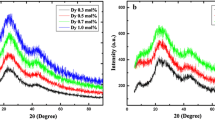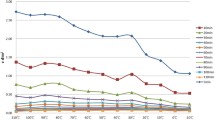Abstract
As the first step of Self-luminous Glass Tube (SLGT) mass production and DB construction, the characterization and the optimization of a phosphor coating were attempted by using a cathodoluminescence (CL) device. The experiment was divided into three parts: measurement of the relative luminance at various exciting conditions, measurement of the absolute luminance at 4 keV, and a degradation experiment. The relative luminances were measured at various conditions with different phosphor thicknesses, energies and current densities. Regardless of the energies, as the current density increased, and the thickness decreased, the relative luminance increased. The absolute luminance was measured at only 4 keV. Absolute luminance at other energies was estimated from relative luminance data by using a conversion factor calculated from absolute and relative luminance measured at 4 keV. We tried to estimate the expected life of SLGT, which is limited by the reduction of the phosphor efficiency and the amounts of tritium, by additional degradation experiments under severe conditions. The luminance of a 10 Μm film was much higher than that of a 20 and 45 μm at the initial stages. On the other hand, the decreasing rate of the luminance at 10 μm was more drastic than that of a 20 and 45 μm. We could see burnt-out spots only on the 10 μm samples. The other samples (20 and 45 μm) were not showing any burnt-out spots
Similar content being viewed by others
References
Abrams, B. L., Roos, W., Holloway, P. H. and Swart, H. C., “Electron Beam-induced Degradation of Zinc Sulfide-based Phosphors,”Surface Science,451, 174 (2000).
Bingle, R. L., Koops, R. L. and Lynam, N. R.,Safety Release for a Trunk of a Vehicle, US Patent, 6,390,529 B (2002).
Caffarella, T. E., Radda, G J. and Dooly, H. H. Jr.,Miniature Radioactive Light Source and Method of its Manufacture, US Patent, 4,213,052(1980).
Chung, H., Ahn, D. H., Paek, S. W., Koo, J. H., Kuk, I. H., Lee, H. S. and Kim, K. R.,Use of Tritium in the Production of Self-luminous Compounds, KAERI /AR-411 (1994).
Hillie, K. T. and Swart, H. C., “Electron Beam Induced Degradation of a Pulsed Laser Deposited ZnS: Cu, Al, Au, Al Thin Film on a Si(100) Substrate,”Appl. Surface Science,183, 304 (2001).
Igarashi, T., Kusunoki, T., Ohno, K., Isobe, T. and Senna, M., “Degradation Proof Modification of ZnS-based Phosphors with ZnO Nanoparticles,”Mater. Research Bulletin,36, 1317 (2001).
Kim, K., Kim, K. S., Son, S. H. and Kim, W.-S., “Manufacturing Process of SLGT Utilizing Tritium Gas: Design of Tritium Handling Facilities,”Korean J. Chem. Eng.,21, 562 (2004).
Kim, K., Lee, S.-K., Chung, E.-S., Kim, K. S., Kim, W.-S. and Nam, G.-J., “Tritium Application: Self-Luminous Glass Tube (SLGT),”Key Eng. Mater.,277-279, 698 (2005).
Kim, W.-S., Jung, Y.-G., Kim, K., Lee, S.-K. and Song, K.-M., KEPRI Report, TM.00NP34.T2001.175 (2001).
Kim, W.-S., Son, S.-H., Kim, K., Lee, S.-K. and Song, K.-M.,Development of Tritium Removal Technology (I), 96NJ18 KHNP Report (2002).
McNair, R. C.,Self-luminous Light Source, US Patent, 4,990,804 (1991).
Oosthuizen, L., Swart, H. C., Viljoen, P. E., Holloway, P. H. and Berning, G L. P., “ZnS: Cu, Al, Au Phosphor Degradation under Electron Excitation,”Appl. Surface Science,120, 9 (1997).
Son, S. H., Kim, K., Kim, K. S., Shon, C.-H., Yeom, C.-S. and Nam, G.-J.,A Domestic Production of SLGT for Rifle View Sights, Proceedings of 2004 Annual Conference, The Korea Institute of Military Science and Technology, 520 (2004).
South African Standard,Symbolic Safety Signs, Part 2: Self-luminous (radio -luminescent) Signs, SABS 1186 (1997).
Author information
Authors and Affiliations
Corresponding author
Rights and permissions
About this article
Cite this article
Kim, K., Kim, K.S., Son, S.H. et al. Manufacturing process of self-luminous glass tube utilizing tritium gas: Experimental results for DB construction. Korean J. Chem. Eng. 22, 905–909 (2005). https://doi.org/10.1007/BF02705673
Received:
Accepted:
Issue Date:
DOI: https://doi.org/10.1007/BF02705673




